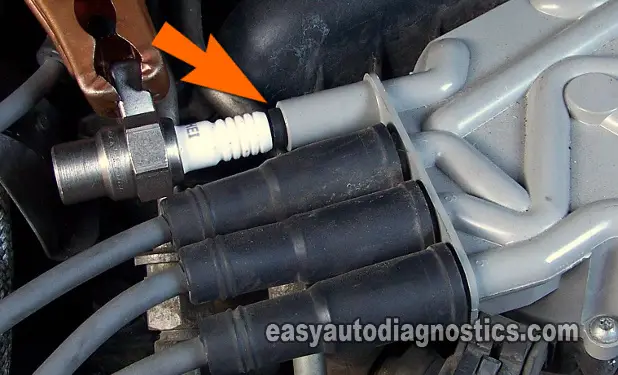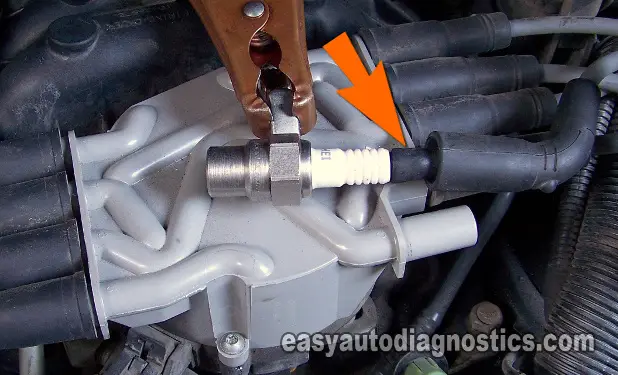TEST 1: Testing For Spark At The Spark Plug Wires

The starting point of your misfire or no-start diagnosis is to check for spark at the spark plug wires.
My recommendation is to test all spark plug wires for spark even if you may already have a specific cylinder that you want to test first (if you have a specific misfire diagnostic trouble code: P0300, P0301, P0302, P0303, P0304, P0305, P0306, P0307, P0308).
I want to stress the importance of using an HEI spark tester to do all spark testing. Here are a few other important suggestions:
- Do not use a regular spark plug in place of a spark tester.
- Do not disconnect the spark plug wire from the spark plug while your helper is cranking the engine to check for spark. This will damage the ignition coil if it isn't already fried.
OK, here we go:
- 1
Remove the spark plug wire from its spark plug.
- 2
Attach the HEI spark tester (or an equivalent spark tester) to the spark plug wire (as shown in the photo above).
Don't have an HEI spark tester? Need to buy one? You can buy it here: OTC 6589 Electronic Ignition Spark Tester). - 3
Ground the HEI spark tester to the battery negative (-) terminal with a battery jump start cable (see photo above).
- 4
Have your helper crank the engine while you observe the spark tester.
- 5
The spark tester will do one of two things: Spark or Not Spark.
- 6
Repeat the test for all of the remaining spark plug wires.
Let's take a look at what your test results mean:
CASE 1: You got spark on all of the spark plug wires. This is the correct and expected test result and it tells you that the ignition control module (ICM), ignition coil, distributor rotor and cap are good.
Having all of the spark plug wires firing off spark eliminates all of these components as the cause of your misfire codes or 'no-spark, no-start' condition. For some suggestions as to what could be the cause of the misfire condition and/or misfire codes, go to: Other Causes Of A Misfire.
CASE 2: You got NO spark from any (none) of the spark plug wires. The next step is to check if the ignition coil is generating spark and sending it to the distributor cap. Go to: TEST 3: Testing The Ignition Coil's High Tension Wire.
CASE 3: You got spark on some but not all of the spark plug wires. The next step is check for spark directly on the distributor cap towers that feed spark to those wires that did not spark. Go to: TEST 2: Testing For Spark At The Distributor Cap.
TEST 2: Testing For Spark At The Distributor Cap

With this type of GM ignition system, it's common for a spark plug wire or two to fail, or for a distributor cap tower or two to fail and cause a misfire because the spark plugs they are connected to are not receiving spark.
In this test step, we'll find out whether the spark plug wires that did not spark in TEST 1 are bad or not.
This test step will also help you see if the distributor cap is bad or not.
IMPORTANT: This test only applies if one or more (but not all) of the spark plug leads have failed to spark!
OK, to get this test going, this is what you need to do:
- 1
Disconnect the spark plug wire that did not spark from its tower on the distributor cap.
- 2
Connect the spark tester directly on the tower.
NOTE: You'll need to use a small piece of vacuum hose to attach the HEI spark tester to the cap tower being tested. - 3
Ground the spark tester to the battery negative (-) terminal with battery jump-start cable.
The battery jump-start cable will help you hold the spark tester to the tower. - 4
Have your assistant crank the engine while you observe the spark tester.
- 5
You're gonna' get one of two results: Spark or No Spark.
- 6
Repeat this test with the others that did not fire off spark (if applicable).
Let's analyze each of these results below:
CASE 1: You got spark. This test result confirms the spark plug wire is bad, replace all as a set.
Replacing the spark plug wires will resolve your misfire condition and misfire codes illuminating the check engine light (CEL). If the rest of the distributor components (distributor cap and rotor) are as old as the spark plug wires you're replacing, I recommend replacing them as well.
Here's the why of the NO spark result: As the spark plug wire ages, its normal spark resistance increases to the point where it cannot conduct spark to the spark plug. This will result in either a misfire or lack of power or an engine non-start condition. Spark plug wires don't last forever, especially after-market ones (average life is 3 to 4 years).
If you want to save money on these parts, check out the section: Where To Buy The OE Parts And Save $$.
CASE 2: You got NO SPARK. This test result is a clear indication that the distributor cap is defective. Replace distributor cap and distributor rotor as a set.
Replacing the distributor cap and rotor should solve your misfire problem. If the rest of the distributor components (spark plug wires and spark plugs) are as old as the distributor cap and rotor you're replacing, I recommend replacing them as well.
Here's why: As the distributor cap ages, the terminals that transmit the spark to the spark plug wires corrode. This corrosion increases spark resistance and over time (as more corrosion develops) the same corrosion will prevent the spark from passing through to the spark plug wires.
TEST 3: Testing The Ignition Coil's High Tension Wire

If you've reach this point, your test results confirm that none of the spark plug wires are sparking.
This lack of spark from all of the spark plug wires could be caused by a bad ignition coil high tension wire or a bad distributor cap.
To investigate this, we'll test the spark plug wire (high tension wire) that carries spark from the ignition coil to to the distributor.
Your test result will indicate whether the high tension wire or distributor cap is defective.
Let's get started:
- 1
Remove the spark plug wire that is attached to the center of the distributor cap.
The other end of this spark plug wire needs to stay on the ignition coil. This is important! See the photo above. - 2
Attach the HEI spark tester to this wire.
- 3
Ground the HEI spark tester to the battery negative (-) terminal with a battery jump start cable.
- 4
Ask your helper to crank the engine while you watch for spark jumping across the air gap of the spark tester.
- 5
You're gonna' get one of the 2 results: (1) Spark or (2) No Spark.
Let's analyze each result in more detail below:
CASE 1: The spark tester sparked. This is the correct test result and confirms that the ignition coil high voltage wire is good and that the ignition coil itself is also good.
Through a process of elimination, these tests confirm that the distributor cap is bad. Replace the distributor cap and rotor as a set and your no-start problem should be resolved.
CASE 2: The spark tester DID NOT spark. Further testing is then required to determine if the problem is due to a faulty ignition control module (ICM), ignition coil, pickup coil, or something else.
For your next test, go to: TEST 4: Spark Test At Ignition Coil Tower.
